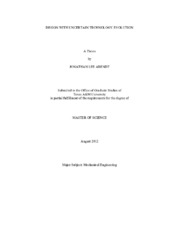| dc.description.abstract | Design is an uncertain human activity involving decisions with uncertain outcomes. Sources of uncertainty in product design include uncertainty in modeling methods, market preferences, and performance levels of subsystem technologies, among many others. The performance of a technology evolves over time exhibiting improving performance as research and development efforts continue. As the performance of a technology in the future is uncertain, quantifying the evolution of these technologies poses a challenge in making design decisions. Designing systems involving evolving technologies is a poorly understood problem. The objective of this research is to create a computational method allowing designers to make decisions encompassing the evolution of technology. Techniques for modeling evolution of a technology that has multiple performance attributes are developed. An S-curve technology evolution model is used. The performance of a technology develops slowly at first, quickly during heavy R&D effort, and slowly again as the performance approaches its limits. Pareto frontiers represent the set of optimal solutions that the decision maker can select from. As the performance of a technology develops, the Pareto frontier shifts to a new location. The assumed S-curve form of technology development allows the designer to apply the uncertainty of technology development directly to the S-curve evolution model rather than applying the uncertainty to the performance, giving a more focused application of uncertainty in the problem. Monte Carlo simulations are used to the propagate uncertainty through the decision. The decision-making methods give designers greater insight when making long-term decisions regarding evolving technologies. The scenario of an automotive manufacturing firm entering the electric vehicle market deciding which battery technology to include in their new line of electric cars is used to demonstrate the decision-making method. Another scenario of a wind turbine energy company deciding which technology to invest in demonstrates a more sophisticated technology evolution modeling technique and the decision making under uncertainty method. | en |


